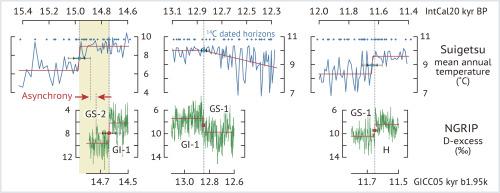Global and Planetary Change ( IF 4.0 ) Pub Date : 2021-05-01 , DOI: 10.1016/j.gloplacha.2021.103493 Takeshi Nakagawa , Pavel Tarasov , Richard Staff , Christopher Bronk Ramsey , Michael Marshall , Gordon Schlolaut , Charlotte Bryant , Achim Brauer , Henry Lamb , Tsuyoshi Haraguchi , Katsuya Gotanda , Ikuko Kitaba , Hiroyuki Kitagawa , Johannes van der Plicht , Hitoshi Yonenobu , Takayuki Omori , Yusuke Yokoyama , Ryuji Tada , Yoshinori Yasuda

|
Leads, lags, or synchronies in climatic events among different regions are key to understanding mechanisms of climate change, as they provide insights into the causal linkages among components of the climate system. The well-studied transition from the Lateglacial to early Holocene (ca. 16–10 ka) contains several abrupt climatic shifts, making this period ideal for assessing the spatio-temporal structure of climate change. However, comparisons of timings of past climatic events among regions often remain hypothetical because site-specific age scales are not necessarily synchronised to each other. Here we present new pollen data (n = 510) and mean annual temperature reconstruction from the annually laminated sediments of Lake Suigetsu, Japan. Suigetsu's 14C dataset is an integral component of the IntCal20 radiocarbon calibration model, in which the absolute age scale is established to the highest standard. Its exceptionally high-precision chronology, along with recent advances in cosmogenic isotope studies of ice cores, enables temporally coherent comparisons among Suigetsu, Greenland, and other key proxy records across regions.
We show that the onsets of the Lateglacial cold reversal (equivalent to GS-1/Younger Dryas) and the Holocene were synchronous between East Asia and the North Atlantic, whereas the Lateglacial interstadial (equivalent to GI-1/Bølling-Allerød) started ca. two centuries earlier in East Asia than in the North Atlantic. Bimodal migration (or ‘jump’) of the westerly jet between north and south of the Tibetan plateau and Himalayas may have operated as a threshold system responsible for the abruptness of the change in East and South (and possibly also West) Asia. That threshold in Asia and another major threshold in the North Atlantic, associated with switching on/off of the Atlantic meridional overturning circulation (AMOC), were crossed at different times, producing a multi-centennial asynchrony of abrupt changes, as well as a disparity of climatic modes among regions during the transitional phases. Such disparity may have disturbed zonal circulation and generated unstable climate during transitions. The intervening periods with stable climate, on the other hand, coincided with the beginnings of sedentary life and agriculture, implying that these new lifestyles and technologies were not rational unless climate was stable and thus, to a certain extent, predictable.
中文翻译:

从Suigetsu湖的花粉记录重建了晚冰川至全新世过渡的时空结构,并与其他主要全球档案有精确的联系:对古气候学和考古学的启示
不同地区之间气候事件的先行,滞后或同步性是了解气候变化机制的关键,因为它们提供了对气候系统各组成部分之间因果关系的见解。经过充分研究的从晚冰期到全新世(约16-10 ka)的过渡包含几个突变的气候变化,这使得该时期非常适合评估气候变化的时空结构。然而,由于特定地点的年龄尺度不一定彼此同步,因此经常对区域之间过去气候事件的时间进行比较仍然是假设的。在这里,我们介绍了新的花粉数据(n = 510),并从日本Suigetsu湖的年积层沉积物中重建了年平均温度。穗月的14C数据集是IntCal20放射性碳校准模型的组成部分,在该模型中,绝对年龄标度已建立到最高标准。其异常高精度的年表,以及冰芯的宇宙成因同位素研究的最新进展,使得Suigetsu,格陵兰岛和其他主要代理记录之间的时间连贯比较得以实现。
我们表明,Lateglacial冷逆转的起始(相当于GS-1 /新仙女木)和全新世是东亚和北大西洋之间的同步,而Lateglacial interstadial(相当于GI-1 /博林-Allerød)启动CA 。东亚比北大西洋早两个世纪。青藏高原北部和南部与喜马拉雅山之间的西风急流的双峰迁移(或“跳跃”)可能已成为造成东亚和南亚(可能还有西亚)突变突然发生的一个门槛系统。亚洲的门槛值和北大西洋的另一个主要门槛值(与开启/关闭大西洋子午翻转循环(AMOC)有关)在不同的时间越过,产生了一个百年的突变突变和差异。过渡阶段区域之间的气候模式变化 这种差异可能会扰乱地带环流,并在过渡期间产生不稳定的气候。另一方面,气候稳定的时期











































 京公网安备 11010802027423号
京公网安备 11010802027423号